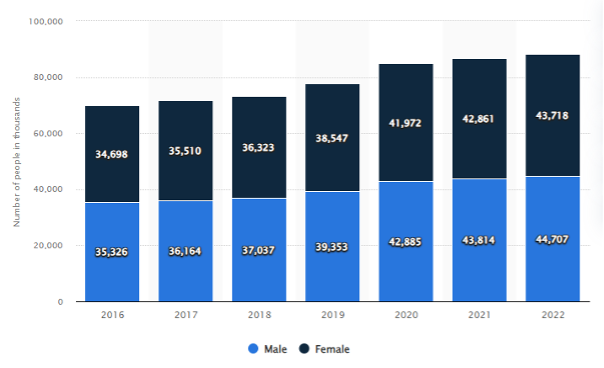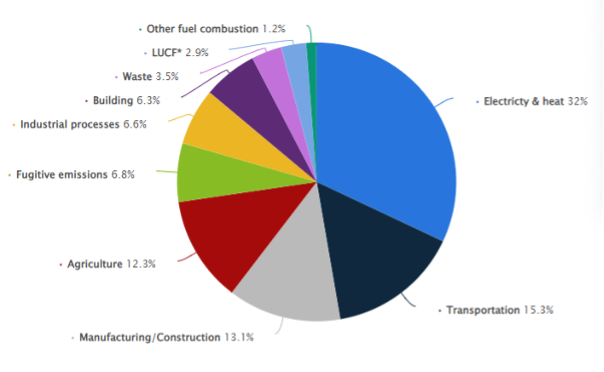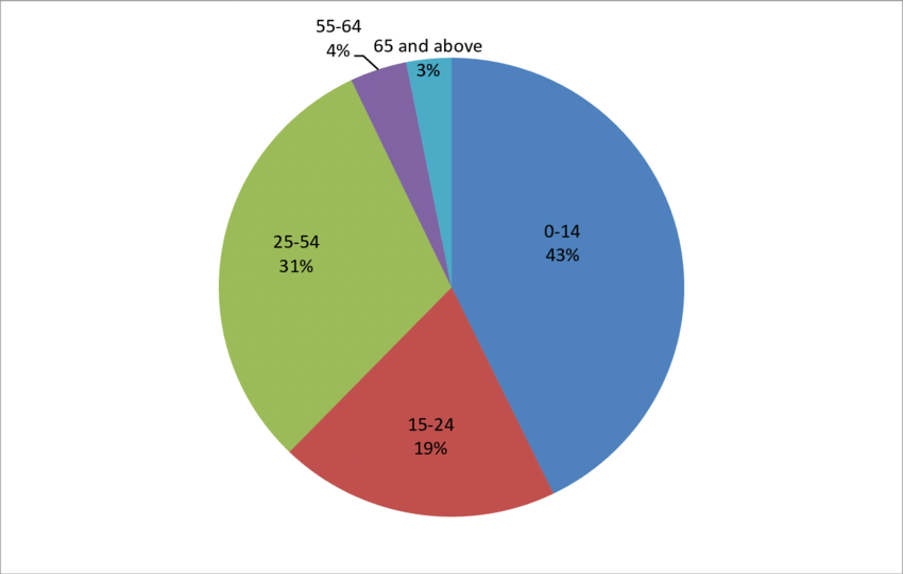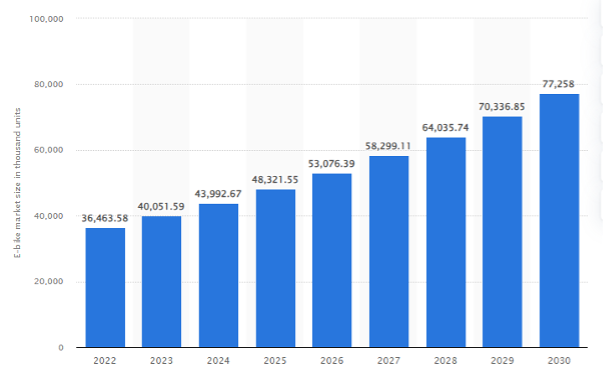The transportation challenges that Nigerians and small businesses face on a daily basis due to recent policy changes, hiked fuel prices, inflation and other factors, necessitate a review of the transportation sector. As Internal combustion engine (ICE) vehicles have negative impacts on the climate transition, including high GHG emissions and high health risks, this article explores an alternative means of transportation such as electric bikes (e-bikes) in Nigeria. An E-bike is a bicycle that is powered by electricity and propelled by pedals. It becomes a viable alternative because of its cost-effectiveness, low carbon footprint, and health risk-mitigating potential. This article explores the remarkable offerings of e-bikes and carefully analyzes how each offering benefits the Nigerian population; making a case for the mass adoption of e-bikes as an alternative means of transportation in Nigeria. It concludes with anticipated challenges that the adoption of e-bikes might pose to Nigerians and possible recommendations.
Transportation cost-effectiveness
The recent fuel subsidy removal coupled with the growing inflation rate in Nigeria has resulted in a roughly 98% increase in the cost of commuting to work, school, or other essential places in the country. With approximately 88.4 million Nigerians already living in extreme poverty as displayed in Figure 1, this situation further exacerbates the financial hardships faced by low-income individuals struggling to make ends meet and vulnerable communities. The exacerbated financial hardship has led to reduced purchasing power of consumers and a consequent reduction in the demand for products and services offered by small businesses, in addition to an increase in their cost of production, and supply chain disruptions. Hence a need to consider an alternative cost-effective means of transportation.

Figure 1: Number of people living in extreme poverty in Nigeria from 2016 to 2022, by gender(in 1,000s)
In comparison to vehicles, e-bikes are significantly cheaper, require less maintenance, and are less expensive to operate. Research shows that only 2% of the Nigerian population can afford to buy new vehicles, and roughly 63% of the population cannot afford to own a car without some form of support. With the current N360,000 ($464) annual minimum wage in Nigeria and the average N110,000 – N300,000 purchasing price of an e-bike, an average Nigerian can considerably afford to purchase and maintain an e-bike. Additionally, e-bikes use electric motors with batteries as power sources to run, hence, they have zero fuel cost and require minimal maintenance.
Low carbon footprint
In addition, e-bike’s low carbon footprint can significantly contribute to the reduction of GHG emissions in Nigeria. The transport sector is a renowned source of GHG emission in the atmosphere, accounting for the second largest emissions globally (figure 2), due to the burning of petroleum-based fuels, such as diesel and gasoline, in internal combustion engine vehicles. This internal combustion engine powers roughly 11.8 million vehicles in Nigeria, leading to a remarkable contribution to the GHG emissions in the country and climate change. Recent research shows a 50% projected increase in the country’s GHG emissions from the transport sector by 2035 and an almost 100% increase by 2050.
 Figure 2: Global distribution of greenhouse gas emissions by sector
Figure 2: Global distribution of greenhouse gas emissions by sector
Tackling the current GHG contributions from the transport sector, in addition to projected contributions demands the adoption of solutions like e-bikes which have low carbon footprint at both manufacturing and utilization levels. The European Cycling Federation estimates that manufacturing an e-bike has a carbon footprint of 134 kg, which is considerably less than the 13 tons required to make an SUV. In addition, according to research, switching from a daily car journey to an e-bike can save an average of 249 g of CO2 for every 1 km travelled, as a typical car emits roughly 220g CO2e/km, while an e-bike emits approximately 21-25g CO2e/km.
Health risks mitigation
Furthermore, e-bike riding proffers enormous health benefits. Like a regular bike, it has a pedal assist with an added boost of an electric motor which provides a form of low-impact exercise. Contrary to popular belief that e-bikes are not a form of exercise because they require less effort, a study conducted at Brigham Young University and published in the Journal of Medical Internet Research found that people who ride electric bikes experience nearly as much exercise as those who ride conventional bikes. Hence, e-bike riding provides similar health benefits as conventional bicycles including improved brain health, enhanced core strength, lower stress level, decreased risk of heart disease, stroke and diabetes, lower blood pressure, and weight control among others.
Among these remarkable health benefits is its ability to preserve muscle mass, strength and function; an immensely advantageous benefit for the fast-growing Nigerian population. According to Harvard Medical School, age-related muscle loss called Sarcopenia, begins at age 30, at which point human beings generally begin to lose as much as 3% to 5% of their muscle mass and strength per decade leading to greater weakness and less mobility, both of which may increase the risk of falls and fractures. However, research has shown that exercise can slow down the rate of Sarcopenia. As displayed in Figure 2, 50% of the country’s population is between the ages of 15 – 30 years old and 30 – 54 years old. These are two critical age brackets in the prevention of Sarcopenia. Exercising via e-bikes can enhance the building and storage of lean muscle mass, which prevents the storage of extra fat in the body and reduces the effects of Sarcopenia in later years for category A; while significantly slowing the progression of Sarcopenia for category B.
 Figure 3: Nigeria’s population in percentage distribution by age
Figure 3: Nigeria’s population in percentage distribution by age
Increased revenue
Finally, the adoption of e-bikes holds potential economic benefits for the country in various ways. It can decrease the country’s expenses on health risks that can be prevented by regular exercise, which include heart disease, stroke, diabetes, cancers, hypertension and mental health breakdown among others. As shown in figure 4, preventable cardiovascular diseases like stroke and heart disease rank among the leading causes of death in Nigeria, hence consuming roughly N857 million in the government’s annual budget. These expenses can be reduced or totally re-invested in other areas of the health sector or the economy if exercise habits are encouraged among citizens with e-bike adoption.
 Figure 3: Main causes of death in Nigeria
Figure 3: Main causes of death in Nigeria
In addition to this, its adoption can propel the growth of Nigerian-based electric mobility startups, thereby creating a thriving local market for them with viable exporting opportunities and indirectly contributing to the nation’s economic growth in terms of employment, logistics, utility bills, and revenue generation among others. As of Q2 2023, a report shows that the tech sector contributed 19.54% to Nigeria’s GDP, the second-highest contributor in the country. This contribution can significantly increase with adequate investment in the production, adoption and most importantly exportation of e-bikes, as data shows that the global e-bike market is projected to climb at a compound annual growth rate of almost 10% between 2022 and 2030 (figure 4).
 Figure 4: Projections for the global electric bike market volume between 2022 and 2030 (in 1,000s)
Figure 4: Projections for the global electric bike market volume between 2022 and 2030 (in 1,000s)
In conclusion, e-bike undoubtedly holds immense potential benefits for Nigerians, but its adoption exposes major infrastructural weaknesses in the country that might pose significant challenges. For example, e-bikes depend on electricity to operate, however, Nigeria has the lowest access to electricity globally, with almost 40% of its population completely lacking access to electricity while 60% only access unstable electricity. In addition, Nigerian roads lack safe walking and cycling infrastructure such as dedicated bicycle lanes, traffic control systems, and alternative routes, which can pose major security threats to cyclists. Data shows that 30% of road fatalities in Nigeria can be traced to pedestrians’ deaths and roughly 1.3 million people die each year on the roads, almost half of whom are pedestrians, cyclists and motorcyclists. Hence, a need for strong efforts and commitments from core players and institutions in the country. This includes the provision of infrastructure that would ease the adoption of e-bikes, and the enactment of favourable regulations and policies including incentives to encourage its production, purchase, usage and exportation. Also, investors need to finance electric mobility startups in the country, and the third sector, especially NGOs, needs to create more awareness among the citizens on the need for mass adoption of e-bikes.
About the Author(s)
Olayide Oyeleke is an associate at The AR Initiative; where Dr Emma Etim is the Head of Research.